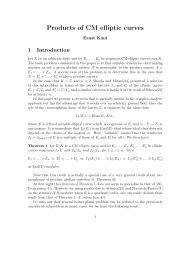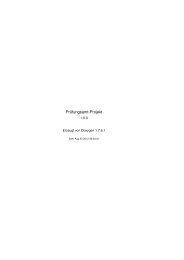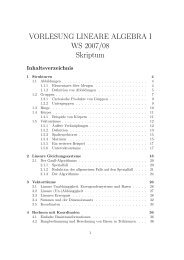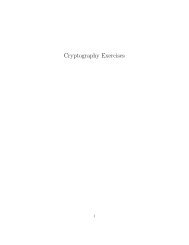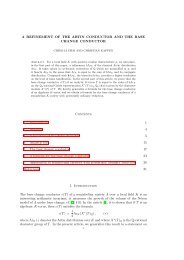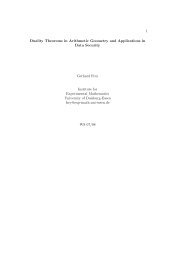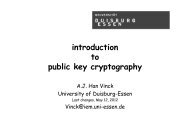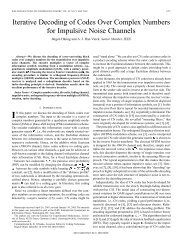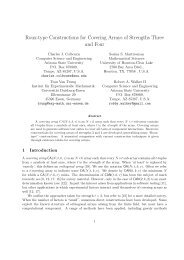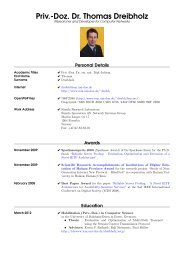UNIFORMLY RIGID SPACES 1. Introduction Let K be a non ...
UNIFORMLY RIGID SPACES 1. Introduction Let K be a non ...
UNIFORMLY RIGID SPACES 1. Introduction Let K be a non ...
You also want an ePaper? Increase the reach of your titles
YUMPU automatically turns print PDFs into web optimized ePapers that Google loves.
<strong>UNIFORMLY</strong> <strong>RIGID</strong> <strong>SPACES</strong> 27III.5.2 Theorem 1, we conclude that A → B n is flat for all maximal idealsn in B, which implies that A → B is flat.Lemma 2.46. The semi-affinoid subspaces of a uniformly rigid K-space Xform a basis for the G-topology on X.Proof. <strong>Let</strong> (X i ) i∈I <strong>be</strong> an admissible semi-affinoid covering of X, and letU ⊆ X <strong>be</strong> an admissible open subset. Then (X i ∩ U) i∈I is an admissiblecovering of U. For each i ∈ I, X i ∩ U is admissible open in X i and, hence,admits an admissible covering by semi-affinoid subdomains of X i . Hence,U has an admissible semi-affinoid covering.□It follows that if X is a uniformly rigid K-space and if U ⊆ X is an admissibleopen subset, then (U, O X | U ) is a uniformly rigid K-space, again.It is now clear that the Glueing Theorem [5] 9.3.2/1 and its proof carryover verbatim to the uniformly rigid setting. Similarly, a morphism ofuniformly rigid spaces can <strong>be</strong> defined locally on the domain; this is theuniformly rigid version of [5] 9.3.3/1, and again the proof is obtained byliteral transcription. Furthermore, a uniformly rigid K-space is determinedby its functorial points with values in semi-affinoid K-spaces.We can also copy the proof of [5] 9.3.3/2 to see that if X is a semi-affinoid K-space and if Y is a uniformly rigid K-space, then the set of morphisms fromY to X is naturally identified with the set of K-algebra homomorphismsfrom O X (X) to O Y (Y ).<strong>Let</strong> X <strong>be</strong> an affine formal R-scheme of ff type with semi-affinoid generic fi<strong>be</strong>rX. The associated specialization map sp X which we discussed in Section2.2.1 is naturally enhanced to a morphism of G-ringed R-spaces sp X : X →X. Morphisms of uniformly rigid K-spaces <strong>be</strong>ing defined locally on thedomain, we see that sp X is final among all morphisms of G-ringed R-spacesfrom uniformly rigid K-spaces to X. Using this universal property, we caninvoke glueing techniques to construct the uniformly rigid generic fi<strong>be</strong>r X urigof a general formal R-scheme of locally ff type X, together with a functorialspecialization map sp X : X urig → X which is universal among all morphismsof G-ringed R-spaces from uniformly rigid K-spaces to X; this process doesnot involve Berthelot’s construction. It is easily seen that urig is faithful onthe category of flat formal R-schemes of locally ff type. A formal R-modelof a uniformly rigid K-space X is a formal R-scheme X of locally ff typetogether with an isomorphism X ∼ = X urig . The map sp X is surjective ontothe closed points of X whenever X is flat over R. This follows from Remark2.5, together with the remark that the underlying topological space of X isa Jacobson space, cf. [16] 0.2.8 and 6.4, so that the condition on a point inX of <strong>be</strong>ing closed is local.By Proposition 2.15, the category of semi-affinoid K-spaces has fi<strong>be</strong>red products;following the method outlined in [5] 9.3.5, we see that the category



